Items
Tag is exactly
education
-
2020-03-31
Covid: My Experience in the Pandemic
Covid: My Experience in the Pandemic The pandemic was an unforgettable experience for my family, as well as countless others. During a time of struggle, we faced many unforeseen challenges that were somewhat difficult for our developing minds to comprehend. Not to mention, the greater the understanding, the greater our issue seemed to be. However, in a time of dread, it became a blessing eventually. In the beginning, it was more of an adjusting period. The idea of quarantine rocked our worlds as we could no longer be out and about. Attempting to find creative solutions seemed challenging, which led us to free meals from different businesses attempting to be of service. Not to mention, on Sundays, we were unable to go to church. However, this soon became a blessing as we began doing “church at home”, which quickly led to a strong family bond. Around the middle of covid, things became slightly easier. We were beginning to adapt to the challenges presented to us. We began working with our neighbors’ family to complete online school, which formed an unbreakable bond with them as well. The grandmother of the house made everything go smoothly, and she supported us over the years. Moreover, in previous years, she would work with my siblings and I to ensure our success in academics. Finally, the end of covid felt like the worst. The transition back to school was not without its tribulations. Others like me had lost their sense of self, acting irrationally. In the midst of it all, the grandmother of our neighbor's family caught covid. Unfortunately, she didn't make it. It took a long time, but we came to terms with it and we were truly blessed to have met her and blessed because she was a chapter in our lives. In conclusion, my family as well as my neighbors’ felt the challenges of covid. However, instead of separating us, covid (ironically) brought us closer together than ever before. From bad to blessed, from terrible to terrific, a great tragedy ended up being a valuable experience. In the end, I'm thankful for covid shaping my character and strengthening my loved ones. -
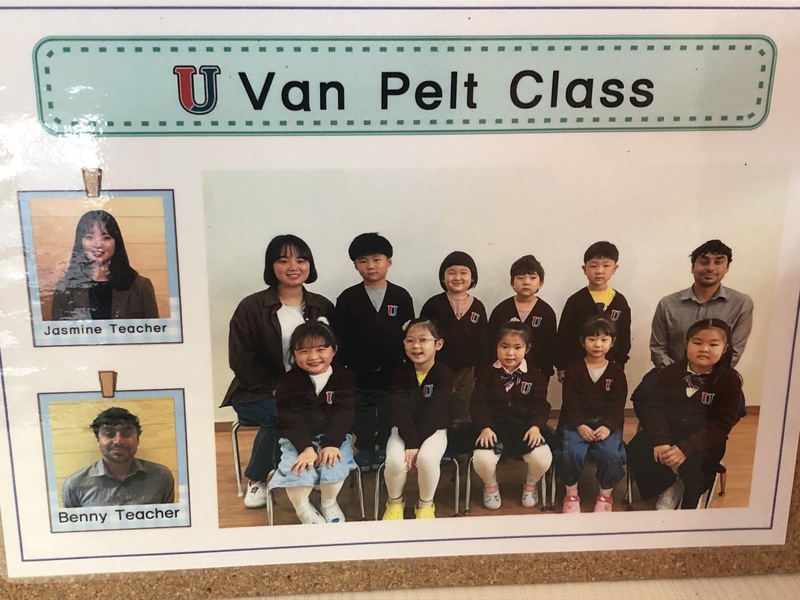 2022-03
2022-03Teaching in Korea
During the height of the pandemic I began to think deeply about what i wanted to do if things ever got "Back to normal." I'd spent my entire life in San Jose California, and decided I wanted to get out and do something different. In early 2021 I went through the process of becoming certified to teach English abroad. I was eventually hired by an English academy in South Korea for a one year contract in the fall of 2021. I enjoyed it so much I ended up re-upping for another year. When I arrived I had to quarantine for one week, and my school director (essentially a principal) picked me up from my quarantine facility and brought me to my apartment, paid for by the school as part of my contract. It was an exciting adventure for me slowly adapting to a new culture and learning to navigate the country of South Korea. The attitude towards COVID was much more serious than in the U.S. The outdoor mask mandate was in force until Spring of 2022, and the indoor mandate was not lifted until January of 2023. Even coming from California, one of the U.S. states with stricter restrictions, it was an adjustment. It certainly wasn't a political issue here in South Korea. I can only speak very rudimentary Korean, but from what I could tell, nobody seemed to have a problem following government health advice. It was illuminating to see how different countries citizens can have radically different views to a crisis based on culture, beliefs, values and attitudes towards Science. Many people still choose to wear masks in public places now in the Summer of 2023. Given the tensions with the North, there is a heavy U.S. military presence in South Korea, which made it easier to connect with other English speakers and get a taste of home near the military bases. I even met my lovely partner here, a space force member stationed in the same city I teach and live in. Being shut in is what drove me to get out of my comfort zone and I'm truly glad for my experience over the past two years in Korea. I've met friends from different countries, experienced aspects of Korean culture that I love, and also have had my privilege checked by aspects of living in Korea that I'm not as fond of. I am excited to go back home this fall, but I hope to carry all I've learned about culture and life in Korea with me. In a strange way, I'm glad that at least the pandemic made me think about what I wanted to do and see once I had the freedom to explore, and I can't say enough how grateful I am for the travel I've been able to do. -
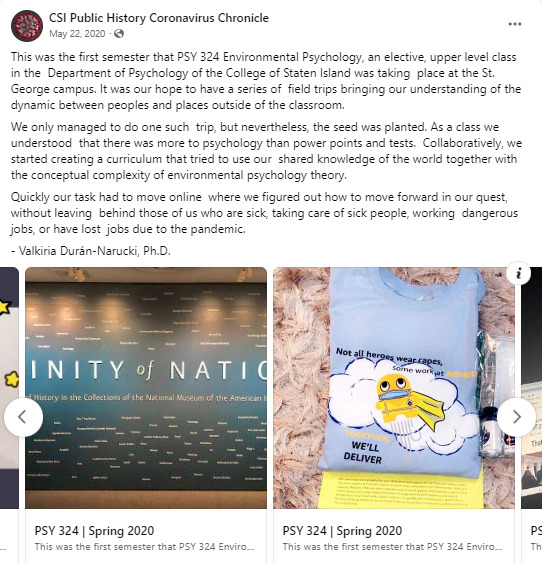 May 22nd, 2020
May 22nd, 2020Environmental Psych. First Semester!
This was the first semester that PSY 324 Environmental Psychology, an elective, upper level class in the Department of Psychology of the College of Staten Island was taking place at the St. George campus. It was our hope to have a series of field trips bringing our understanding of the dynamic between peoples and places outside of the classroom. We only managed to do one such trip, but nevertheless, the seed was planted. As a class we understood that there was more to psychology than power points and tests. Collaboratively, we started creating a curriculum that tried to use our shared knowledge of the world together with the conceptual complexity of environmental psychology theory. Quickly our task had to move online where we figured out how to move forward in our quest, without leaving behind those of us who are sick, taking care of sick people, working dangerous jobs, or have lost jobs due to the pandemic. -
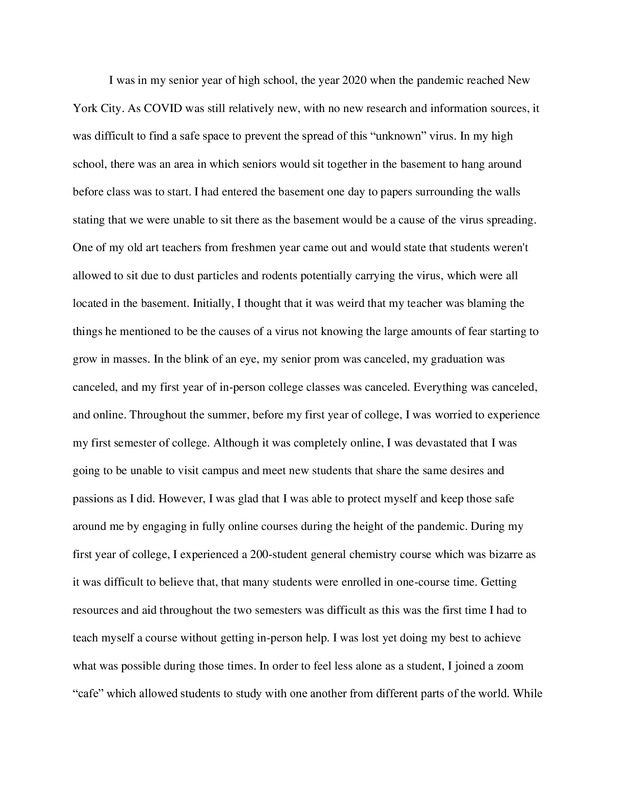 2020-08-05
2020-08-05Only Student on Campus: My First and Second Year at College
The item that I am submitting describes my life as a student throughout my senior year of high school toward my first year of college. I emphasized the feeling of being alone and dealing with the college on a fully virtual level. As months passed it was important to validate the experience and the growth from being in an online setting to an in-person setting. -
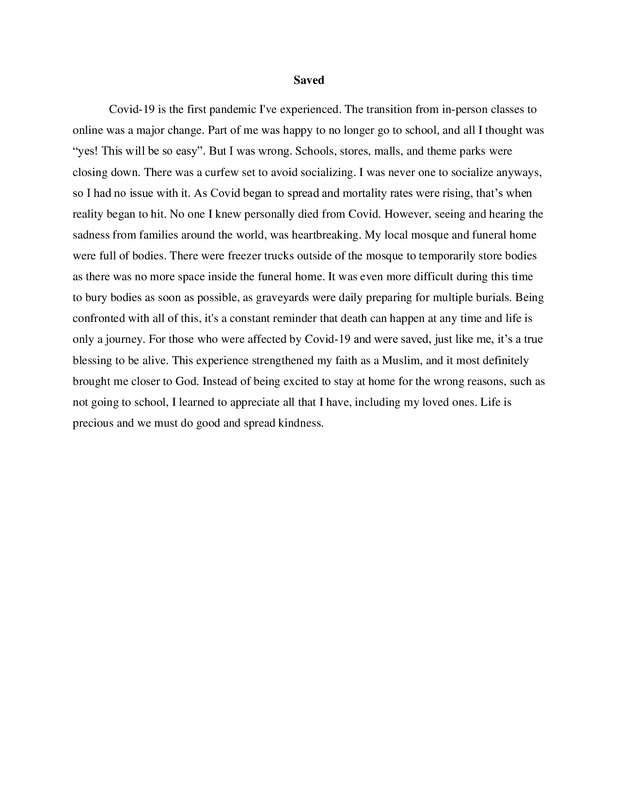 2020-04
2020-04Saved
The pandemic has not only been a devastating experience but a time of reflection. -
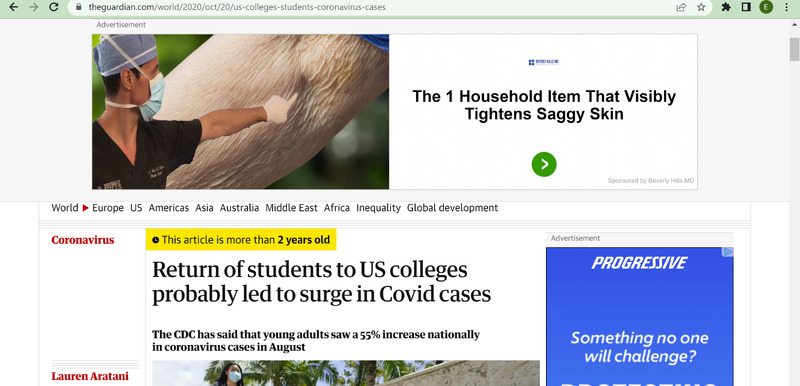 2020-10-20
2020-10-20How covid affected NYC?
Covid has affected everyone by the way you live your everyday life. Covid has affected New york city in many different ways , For example covid affected business to close down months including schools . Schools having to go remote . Another way New york city has been affected by the transit , The transit systems like the trains ,buses and commuter rail and ferries as a result to this the transportation has plummeted . For the subways in New York City it went down 90 percent and the buses went down 75 percent. The reason for this happening is people in quarantine and not going to work since some are working from home . Covid has affected health care workers. For example health care workers like doctors and nurses are around people who have it so they are more prone to get it. .This pandemic caused a lot of changes in the world. It caused everyone to be less social and not go out as much as it caused us to wear masks everywhere. It also caused a lot of people mental and emotional health to go down. For example there’s been a lot of social isolation which caused families to not be able to see each other as often. COVID-19 has impacted social mobility on child care cost and for families school dropout rate has increased due to fear of getting Covid. COVID-19 especially affected families due to not having jobs or working from home or being put on unemployment there’s been a big impact of Covid on families and family relationships creating a lot of tension and feeling depressed or not being united together. These pandemic parts of the population in different situations continue to affect people living in poverty situations with older people and disabilities. A lot of people have been put on unemployment and not being able to pay the rent. Covid has caused a lot of deaths and people could not be able to bury their loved ones. During The beginning of the year when the Pandemic was occurring depending on the situation of others some people were probably affected mentally Health care was provided to those who really needed it due to people not being able to pay for it and The state of new york lost money as well , It affected relationships and people got help by going therapy and staying connected to people . This pandemic affected many people personally. Covid has affected everyone's plan including travel because there's been travel bans and going to the airport has a lot of restrictions. A Lot of businesses are closing down to this pandemic by not giving income . Due to health care a lot of pregnant women had very high dress levels that affected their pregnancy . Which caused health care workers to be very aware of what was going on . Their risking their own lives to help us and young teens and kids were not able to fully able to enjoy the success of completing in graduating either high school such as prom or etc.it affected everyone's life and still is . This has caused a lot of stress and tension but has allowed people to be stronger in a sense and to appreciate the little things in life . Covid 19 has caused many hardships including loss of jobs . Some questions that still remain on this subject would be , When are things going back to normal ?, When is the vaccine coming out to prevent this ? When will this end ?. A message of hope i would say is everything will get better with time. The productivity has been slow due to employment going down ,People losing jobs . my personal experience with covid has become a learning experience . For example this pandemic has showed me to not take things for granted . -
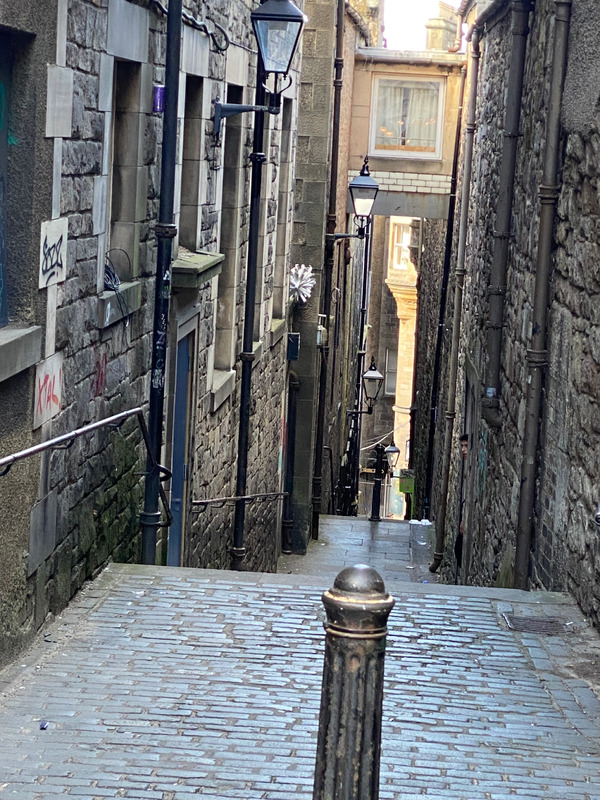 2021-04-18
2021-04-18Edinburgh and Northumberland, "Post Pandemic" Historical Tourism
I had been dreaming of this trip since 1996 when I went to England on a high school theatre and literature trip and fell in love with the UK. Specifically, I fell in love with Scotland and its history, becoming a British History enthusiast. In August, 2021, I completed my BA in History at ASU, then changed careers from Film/tv costuming to a special education teaching position. During the peak age of Covid-19, I worked full time, completed full time undergraduate studies, interned in politics and not-for-profit law, and started over in a new career and life in a new state. All of 2020-2021 was a non-stop adrenaline rush of constantly moving, getting Covid, and burning out mentally along the way. In 2021, I was halfway through a teaching contract and gravely unhappy, longing to just... escape. I kept dreaming of one photo of Edinburgh that was on my vision board. The picture, from Pinterest, was of a narrow Close in Old Town, Edinburgh, the historic "original" city that squeezed so much history and magic in about a mile. Old Edinburgh held tens of thousands of people in one square mile with their Closes serving as narrow alleyways between buildings of both stone and wood, both affluent and poor societal classes. After creating this vision board, I started working a ridiculous amount of overtime in the school's residences for special needs students and saving money. I was used to already working over 60 hours a week, so I didn't see the problem yet. The short staffing crisis of special education staff provided the opportunity to earn $40/ hour plus $1000 monthly bonus for anyone willing to work and be okay with less support for challenging behavior or emergency resources. I was willing to work hard to be free for just a short time over the Easter/Passover School break. Flight and accommodation prices were incredibly low at the start of 2021, encouraging tourists to travel. British Airways and other airlines offered incredible fares! These discounts still enabled me to book more affordable fare into 2023. My flight from Boston to Edinburgh was just over $400, with 7 nights stay in two 4 and 5 star hotels plus one castle for a total of less than $1000. My dream trip was planned to every detail and paid in advance or booked for free with historical memberships. The pandemic and rising popularity of Airbnb and Verbo created the perfect discounts for hotels and upgrades to better suites. Pre-pandemic, I got bed bugs from an Airbnb and had a nightmare of an experience, so it was out of the question for accomodation moving forward. While in planning stages, I booked historical tours and entry into sites like Edinburgh Castle, Mary Kings Close, Ghost Tours of the Vaults, Sterling Castle, then in England, Alnwick Castle and Chillingham Castle's paranormal investigation. I already had memberships to multiple British historical and public sites like the Alnwick Gardens (site of the famous Poison Garden) and Historical Scotland. From Edinburgh Castle to Chillingham Castle, I finally got to see the gallows, dungeons, and artifacts that were in my undergraduate classes. Finances and waiting for a travel companion to finally find "the time" to go held me back from going previously, but I was there, alone, at this particular time for a reason. I got to hold Witches Collars and touch an Iron Maiden that tortured so many innocent "witches". I sat in castle common areas alone with a glass of Whisky and venison sausage while hunting ghosts. Museum staff showed me witches charms and introduced me to folklore that secretly told tales of history in starkly lit archival research rooms. It was this trip that solidified by decision to continue onto graduate studies in history at ASU. It was this trip that made me question, "Why are we so fascinated by death and folklore?" It would be remiss to mention that during my historical tourism of Edinburgh and the Scottish-English Borderlands, the stories of historically significant pandemics and major moments of medical and scientific struggle or discovery were always present- It was..."everything, everywhere, all at once", if you will. The comparisons between Black Death to Cholera to Spanish Flu were ever-present while exploring Mary Kings Close, places of Surgical and Medical History interest, The Vaults, the Grass Market Gallows. I stepped into a cramped spaces that were once the homes of a families who all died of The Plague. White rags hung out the windows of these tourist destinations to remind visitors that it was the way leather beak masked Plague Doctors identified the infected and quarantined. "Haunted" Vaults served as reminders to modern tourists that the poor and disenfranchised once stayed here. If you want to go anywhere in the world to see a pandemic being held with an engrained fear and solemn respect for medical research, it's Scotland. In England, Chillingham Castle and Alnwick Castle allow visitors close proximity to places where prisoners carved each imprisoned day before their deaths into the walls. In Edinbugh, if it isn't a Harry Potter tour, it is a ghost tour. These ghosts are explored with light-hearted entertainment or found during paranormal investigations with high-tech gizmos and Ouiji Boards in this new age when we don't want to talk about how many people died of Covid-19 or a lack of health resources, but pre-modern history when people don't currently hold memory of the dead... One late morning, I went to a pub on the Royal Mile for a proper Scottish breakfast of sausages, haggis, bacon, eggs, tomato, and toast... and a pint. Bagpipes echoed in the air, passers-by spoke different languages and carried their cameras and I (Heart) Scotland t shirts and Whisky. As I sat outside, just taking everything in, a group of domestic tourists sat at my table. We laughed because we were all uncertain of "Mask? no Mask? What does 'optional Mask mean?' Were we bad people for NOT wearing a mask inside the pub to get another beer?" "Is it appropriate to sit so 'close'?" That particular day was the lifting of the Scottish masks in public places mandate. My mates-for-the-day spoke of their quarantines and experiences with Covid-19 and quarantine with both humor and sombre memories. The photo attached to this story was from this day where masks were no longer a must. It is also the same scene from my vision board. On my camera and iPhone camera reels, before this moment and after are dozens of photos of castle chambers, countryside fog, tourist photo ops of High Tea or plain ol Costa Coffee at [Insert Tourist Destination]. My photos are visited with gratitude and inspiration. Not only do I have a renewed desire to travel, but I have a spark of motivation to keep learning. I would never have been able to afford this trip at the level of luxury and privilege I experienced it without the Covid-19 pandemic's aftermath of needed promotional discounts. Misery was everywhere, yes, but joy and purpose were found for me. I hope there were others that experienced incredible change and revelation during this time. -
 2020-08-11
2020-08-11Virtual Learning in California
The American response to the global COVID-19 Pandemic was multi-faceted. However, of specific importance to the nation were the changes made to public education. As the Pandemic resulted in the closure of businesses, teachers and students were required to continue their educational programs online from the privacy of their homes. Although the effects of distance learning will continue to be seen, virtual learning severely limited the ability of students and teachers to use sensory perception as a tool for learning and instruction. First, distance learning no longer enabled American teachers to utilize the sensory perception of “proximity.” Throughout public education “proximity” is used to encourage student engagement with both instruction and content. Many teachers will walk their classrooms during student activities and use sensory perception to sensorially inform students that they are near to them and are assessing their engagement. Teachers use this strategy as a reinforcement tool to develop students’ ability to stay on task. Yet, during the COVID-19 Pandemic, social distancing policies made “proximity” not only impossible, but also illegal, limiting to what extent teachers could use sensory perception to foster engagement and learning. Second, not only were educators no longer allowed to use the sensory perception tool of physical proximity, but also many educators were forced to rely solely on the sensory perception of sound. School districts throughout the state of California, for example, did not permit educators to require their students to verify their attendance in live video format. The result was educators and students were engaging predominantly through speaking and listening. Furthermore, being denied the sensory perception of sight, educators could not assess to what extent students were engaging with instruction and activities. In conclusion, the COVID-19 Pandemic enacted emergency response strategies which directly affected the education of Generation Z. For both students and educators, sensory perception became more limited for every student. Yet, the sciences, including social science, are built upon the empirical information a human being receives through them. Perhaps this video will serve as evidence to answer the question, “To what extent were students denied the right to sensory information and science?” -
2020-08-11
Long-Distance Learning
The American response to the global COVID-19 Pandemic was multi-faceted. However, of specific importance to the nation were the changes made to public education. As the Pandemic resulted in the closure of businesses, teachers and students were required to continue their educational programs online from the privacy of their homes. Although the effects of distance learning will continue to be seen, virtual learning severely limited the ability of students and teachers to use sensory perception as a tool for learning and instruction. First, distance learning no longer enabled American teachers to utilize the sensory perception of “proximity.” Throughout public education “proximity” is used to encourage student engagement with both instruction and content. Many teachers will walk their classrooms during student activities and use sensory perception to sensorially inform students that they are near to them and are assessing their engagement. Teachers use this strategy as a reinforcement tool to develop students’ ability to stay on task. Yet, during the COVID-19 Pandemic, social distancing policies made “proximity” not only impossible, but also illegal, limiting to what extent teachers could use sensory perception to foster engagement and learning. Second, not only were educators no longer allowed to use the sensory perception tool of physical proximity, but also many educators were forced to rely solely on the sensory perception of sound. School districts throughout the state of California, for example, did not permit educators to require their students to verify their attendance in live video format. The result was educators and students were engaging predominantly through speaking and listening. Furthermore, being denied the sensory perception of sight, educators could not assess to what extent students were engaging with instruction and activities. In conclusion, the COVID-19 Pandemic enacted emergency response strategies which directly affected the education of Generation Z. For both students and educators, sensory perception became more limited for every student. Yet, the sciences, including social science, are built upon the empirical information a human being receives through them. Perhaps this video will serve as evidence to answer the question, “Is the right to sensory perception and scientific information included within the natural rights of life, liberty, and property?” -
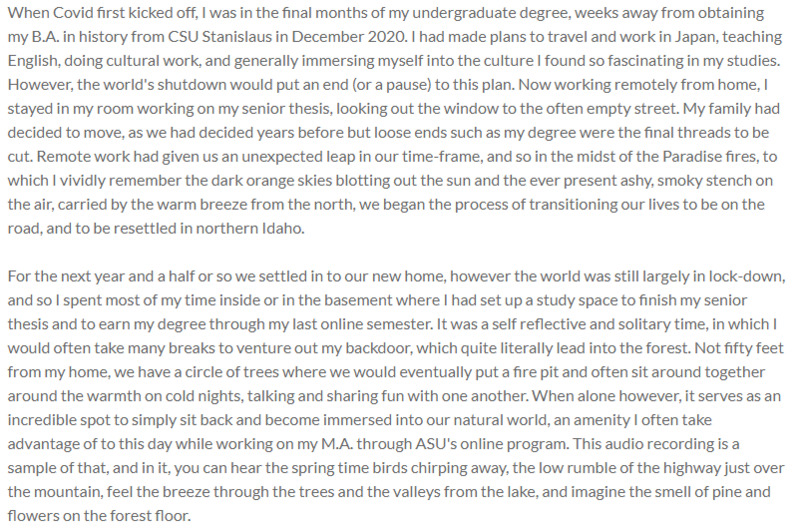 2022-05-26
2022-05-26Relocation in Isolation, Reconnection in Solitude
When Covid first kicked off, I was in the final months of my undergraduate degree, weeks away from obtaining my B.A. in history from CSU Stanislaus in December 2020. I had made plans to travel and work in Japan, teaching English, doing cultural work, and generally immersing myself into the culture I found so fascinating in my studies. However, the world's shutdown would put an end (or a pause) to this plan. Now working remotely from home, I stayed in my room working on my senior thesis, looking out the window to the often empty street. My family had decided to move, as we had decided years before but loose ends such as my degree were the final threads to be cut. Remote work had given us an unexpected leap in our time-frame, and so in the midst of the Paradise fires, to which I vividly remember the dark orange skies blotting out the sun and the ever present ashy, smoky stench on the air, carried by the warm breeze from the north, we began the process of transitioning our lives to be on the road, and to be resettled in northern Idaho. For the next year and a half or so we settled in to our new home, however the world was still largely in lock-down, and so I spent most of my time inside or in the basement where I had set up a study space to finish my senior thesis and to earn my degree through my last online semester. It was a self reflective and solitary time, in which I would often take many breaks to venture out my backdoor, which quite literally lead into the forest. Not fifty feet from my home, we have a circle of trees where we would eventually put a fire pit and often sit around together around the warmth on cold nights, talking and sharing fun with one another. When alone however, it serves as an incredible spot to simply sit back and become immersed into our natural world, an amenity I often take advantage of to this day while working on my M.A. through ASU's online program. This audio recording is a sample of that, and in it, you can hear the spring time birds chirping away, the low rumble of the highway just over the mountain, feel the breeze through the trees and the valleys from the lake, and imagine the smell of pine and flowers on the forest floor. -
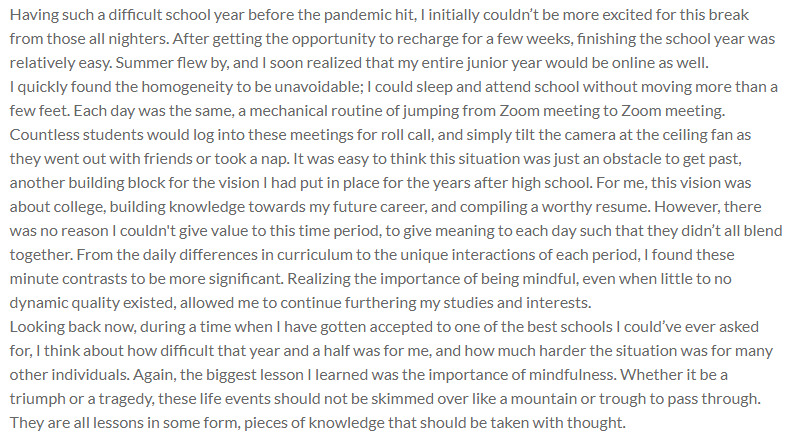 2022-05-20
2022-05-20Online School Problems
Having such a difficult school year before the pandemic hit, I initially couldn’t be more excited for this break from those all nighters. After getting the opportunity to recharge for a few weeks, finishing the school year was relatively easy. Summer flew by, and I soon realized that my entire junior year would be online as well. I quickly found the homogeneity to be unavoidable; I could sleep and attend school without moving more than a few feet. Each day was the same, a mechanical routine of jumping from Zoom meeting to Zoom meeting. Countless students would log into these meetings for roll call, and simply tilt the camera at the ceiling fan as they went out with friends or took a nap. It was easy to think this situation was just an obstacle to get past, another building block for the vision I had put in place for the years after high school. For me, this vision was about college, building knowledge towards my future career, and compiling a worthy resume. However, there was no reason I couldn't give value to this time period, to give meaning to each day such that they didn’t all blend together. From the daily differences in curriculum to the unique interactions of each period, I found these minute contrasts to be more significant. Realizing the importance of being mindful, even when little to no dynamic quality existed, allowed me to continue furthering my studies and interests. Looking back now, during a time when I have gotten accepted to one of the best schools I could’ve ever asked for, I think about how difficult that year and a half was for me, and how much harder the situation was for many other individuals. Again, the biggest lesson I learned was the importance of mindfulness. Whether it be a triumph or a tragedy, these life events should not be skimmed over like a mountain or trough to pass through. They are all lessons in some form, pieces of knowledge that should be taken with thought. -
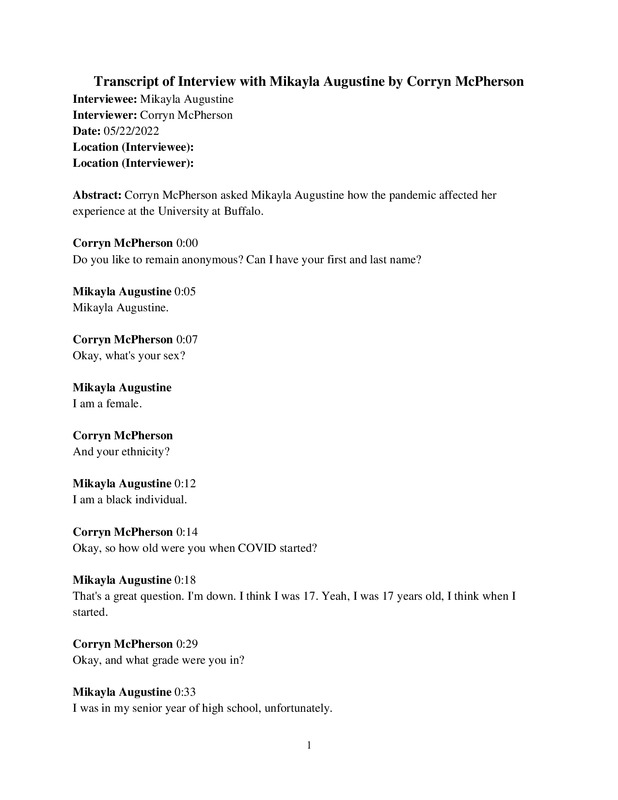 2022-05-15
2022-05-15Mikayla Augustine Oral History, 2022/05/22
I asked the interviewee how the pandemic affected her experience at UB -
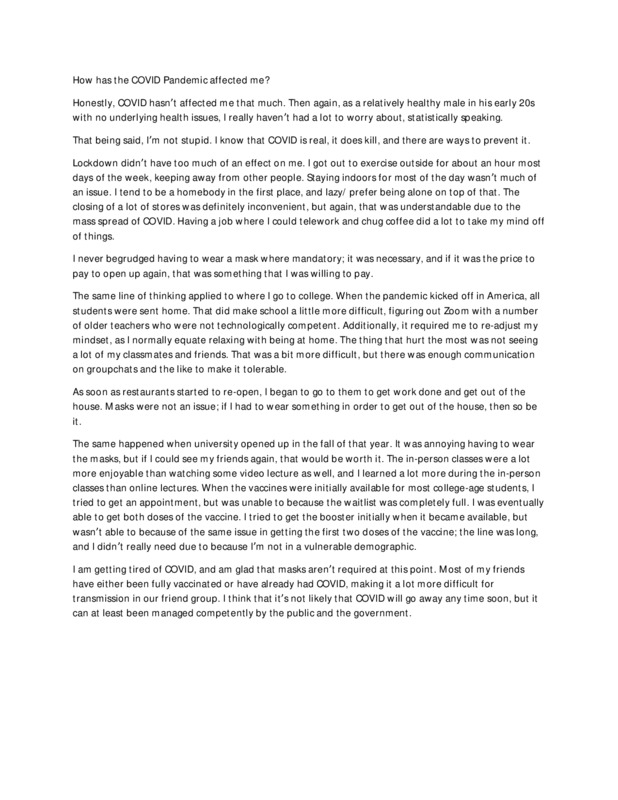 2022-02-01
2022-02-01How I've dealt with COVID
My feelings and how I've dealt with COVID and its restrictions -
2022-05-07
Covid
I have never been one who went out and played or had activities. I like to play video games. However, during the past couple years everything has been pretty tough on everyone. I find myself getting frustrated that many places are closed to me and how boring college life is. I started college two years ago and it was miserable. All there was to do was just to sit in my dorm and play games, watch movies, and do homework. There wasn't any fun in college anymore with the effects of covid. As of now I feel drained in almost every way possible, I am usually an A student and now I am becoming a more C student and it frustrates me and angers me yet I still can't find any motivation to try harder. With the past couple of years all I would like to do is just take a break from everything and just work for a year or so then jump back into it. -
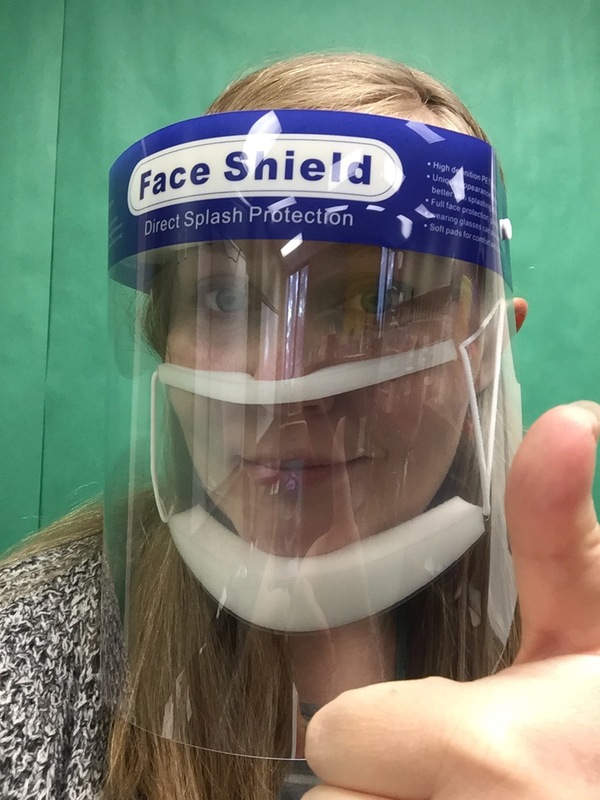 2020-03-15
2020-03-15Together and Apart
Flagstaff AZ. My husband was an occupational therapist who regularly worked in the ICU at Flagstaff Medical Center. I remember the week after the lockdown started (March 15th or so) the Covid-19 numbers were doubling every week at FMC. My husband started changing out of his scrubs and shoes in the garage. I was a speech therapist with the school district and we were all asked to stay home, which was good because I have two school-aged children. As the Covid numbers started to skyrocket in our region due to a devastating outbreak on the Navajo nation, my husband became more and more worried about bringing the virus home since there was a shortage of PPE. When it was announced that my own job would go remote and I would need to start scheduling teletherapy sessions with my students, we decided it would be better for me and the kids to go live with my mom and dad in Tempe for a few weeks. My mom is a retired teacher and offered to teach my kids while I worked with my students online. The kids loved having grandma be their teacher. I had to learn how to work with preschoolers with disabilities over Zoom, which is no easy task! Meanwhile, my husband was providing us updates; when he finally got fitted for a tyvek suit was a happy day because he could spend all day in it helping patients. The doctors were trying new therapies with patients every week, but mostly he saw many people seem to get better and then take unexpected deadly turns. Treating isolated, scared patients while feeling helpless to know what to do was taking a toll on everyone at the hospital. The kids and I spent 7 weeks with my mom, face-timing him every night. Finally, as the school-year came to a close, we were able to reunite. I captured the moment we got home and my husband hugged my 5 year old son. We were so lucky; no one in the family had gotten sick so far despite my husband being in close proximity to patients each day. Over the summer and into the next school year we were hoping for some normalcy to return but it was nothing but adapting to change. The kids made friends with the neighbors down the street not by playing in the front yard, but by yelling greetings over the fence. When they started school in the fall we organized a "pod" with other families whose children were in the same classes as ours at DeMiguel elementary. We had four kindergarteners and three 2nd graders all doing school over Zoom at the same time, which was not easy for the parents who had to oversee them (my husband had the honor at least once a week), but the kids really benefitted from having friends to play with during breaks. We saw them become more motivated to participate and happier overall. I started seeing some students in-person for the first time at the school on a very limited basis. I wore clear PPE products so my students could see my mouth. The kids didn't go back to in-person school until about a year after the lockdown (Spring 2021). As the school year ended, the wildest school year of our lives, things did start to seem normal again, but we ended up leaving Flagstaff for Tucson due to soaring high home prices and my husband needing a fresh start away from the memories of the early pandemic. -
2022-04-29
How Covid- 19 has impacted my life
On the 11th of March 2020, COVID 19 was declared a global pandemic. With such an explosive magnitude and wide reach, the world braced for its impact. Lockdowns were set in place in every country, travel was shut down, and grocery stores were often out of many essential items. Many have lost their jobs or sources of income, Many of us have battled this virus and lost loved ones to it. For better or worse COVID 19 has changed us permanently. The impact of COVID-19 is observed in every sector around the world. It has affected education systems worldwide. After attending classes in person for the majority of my life the transition to being a full-time student online was not a simple adjustment. I encountered feelings of anxiety about my classes and was overwhelmed by having to move back home from the dorms. Thankfully the support from my family was encouraging. Being an online student has taught me more about time management than anything else and procrastination became a close friend. Missing out on class activities and gathering on campus have been discouraging. I felt as though I was missing out on the college experience and felt left out. It's important to remember while I am feeling these emotions so there are many more. Being able to connect with other people and share our experiences have opened up doors to new friendships. I would be lying if I said I did not have trouble going to sleep at night during these difficult times. Especially when I would constantly hear the news about how the elderly are more vulnerable to exposure to the virus. The thought of losing a family member is terrifying. Before the pandemic, I would often visit my family who lives in Mexico once a year during the summer, but traveling was no longer an option, the risk was too high. As times have passed I am more comfortable traveling and being able to see loved ones. Similar to schools, churches also went online. Before COVID I was really involved with the staff team at my local church. I constantly helped with volunteer activities, I helped in the kid's ministry, and I also helped with the church's coffee bar. With the transition online I lost the sense of community and fellowship. Many of the kids graduated out of the program online and it was difficult not to be able to celebrate in person. With every transition, I learned that adapting is the best form of survival, I cannot predict the future and I don't know what this year will unfold, but I will do my best to express gratitude for my health, and for my family’s health. -
2020-03-06
Senior to Sophomore
It was the Friday before Spring Break. Senior year, everyone is joyful with big plans to get out of the harsh Arizona sun. Rumors of a flu-like virus spreading in China were heard but never hit mainstream media which meant, not our problem. I was helping out at our school's Volleyball tournament that day, listening to the new Lil Uzi album that was hyped for so many years, life simply could not get any better. I had secured a good scholarship for college and was nearing the end of my last semester of highschool without a doubt in my mind, but it all changed so quickly. No one knew that would be the last time I saw my graduating class, that I would never have a traditional graduation, that our final plans for the last day of school were all worthless. I still remember the day as if it never ended, the day when everything in my life went upside down and the world was sent into a mass state of panic and depression. Seeing friends was near impossible as everyone was scared of what may happen outside. So many people that I graduated with and interacted with every single day, gone, never to be seen or heard from again. Though Arizona did at first avoid most lockdowns and mask mandates, luckily many people still took the necessary precautions. The first lockdown was possibly the most eventful and enjoyable as everyone was in the same idle and confused state with nothing to do and no aim as for where to go. The rise of a new app called TikTok took the world by storm and provided entertainment for everyone. It was a new place for everyone to connect and share ideas and surely enough, society was instantly hooked. It was the beginning of the new online semester of schooling alongside the second wave of lockdown here that truly began the depressive wave on all students. Many students, as well as I, still to this today are struggling to stay focused in online schooling and this meant very poorly educated and depressed students for over a year. No amount of aid from teachers or staff could cure this lack of socialization and the sole ability to make friends and connections that is required in schools. All of a sudden, fast forward from the middle of my senior year of high school to Sophomore year at university, life has done a full 360 and social interaction is a foreign language. Masks are required so no one knows who is who and friend groups are only for those that pertained throughout the pandemic. -
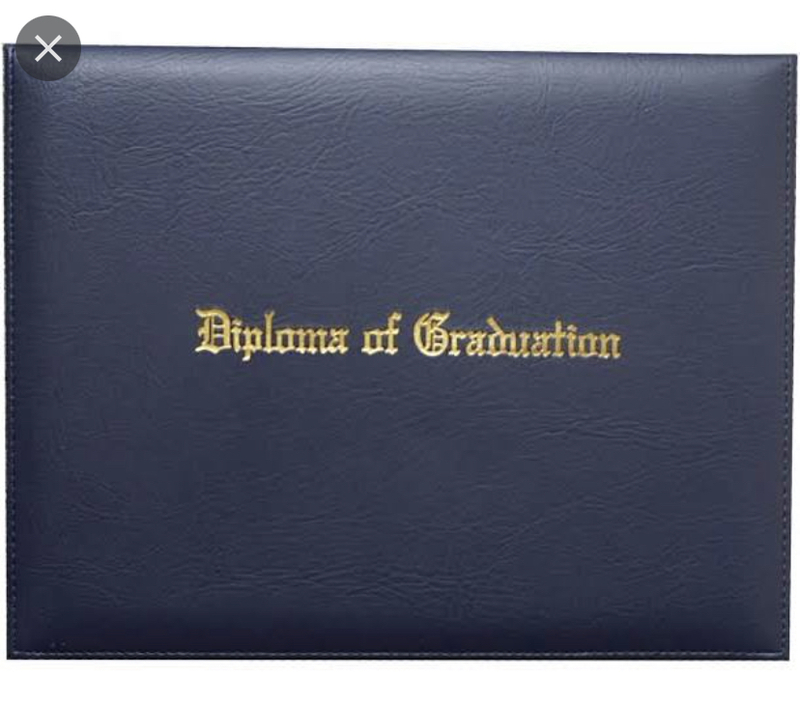 2020-03-15
2020-03-15COVID-19 Impact
COVID-19 took so much from me. It took people, friendships, experiences, and so much more. I have pictured a high school diploma. This represents the years I lost in high school but still pushed through and finished. I’ve lacked education from being online. I lost opportunities and experiences. I lost friends. And had scares of losing my father. Covid took so much from me and many others. -
 2020-03
2020-03Growth Through a Pandemic
The Covid-19 pandemic has brought an array of challenges for not only me, but people across the globe. People have lost loved ones, lost touch with some of their closest friends, got covid themselves, and so much more. Although Covid-19 has taken a long-lasting toll on my life, it has also brought me great change in an extremely positive way. When the pandemic first started my family and I were forced into a “lockdown”, only leaving our house for the essentials like food. I was unable to see my friends as online schooling became more and more prominent. This took such a toll on me both mentally and physically. I was longing for a social connection that I could no longer get and was unable to do one of the things I love to do most, workout. Although at the time I thought it was the worst thing possible, the lockdown caused my family and I to get extremely close. We would have family dinners, play games, and watch movies. The pandemic helped me to realize how much I rely on my family, and that through thick and thin they will always be there for me. As the pandemic progressed, I got accepted into Duquesne University, and started college soon after. This was a huge adjustment for me as I am from Buffalo, three and a half hours away. I had to meet new people and get adjusted to home away from home amid a global pandemic. I had to overcome fear of the unknown and fear of the pandemic to grow as an individual, and I did just that. Through the last three semesters I have met so many amazing people and found the things that make me happy while at Duquesne. I learned to not let fear override you, and that to grow physically and mentally you must overcome fear. Across the entire pandemic I have also learned that sometimes you need to focus on yourself and put yourself first. Throughout the pandemic I got into the habit of going to the gym consistently and began to eat more cleanly. I found joy in the little things, like going to work and building relationships with my fellow employees. In the end, the pandemic taught me to always look on the brightside no matter what and to make the most of everything that is thrown at you, good or bad. Looking back at it, the Covid-19 pandemic helped me grow and become the person I am today. -
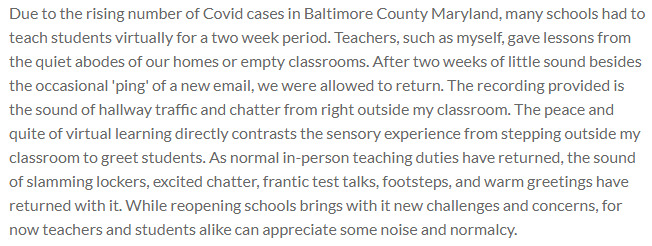 2022-02-03
2022-02-03A Return to Noisy Normalcy
Due to the rising number of Covid cases in Baltimore County Maryland, many schools had to teach students virtually for a two week period. Teachers, such as myself, gave lessons from the quiet abodes of our homes or empty classrooms. After two weeks of little sound besides the occasional 'ping' of a new email, we were allowed to return. The recording provided is the sound of hallway traffic and chatter from right outside my classroom. The peace and quite of virtual learning directly contrasts the sensory experience from stepping outside my classroom to greet students. As normal in-person teaching duties have returned, the sound of slamming lockers, excited chatter, frantic test talks, footsteps, and warm greetings have returned with it. While reopening schools brings with it new challenges and concerns, for now teachers and students alike can appreciate some noise and normalcy. -
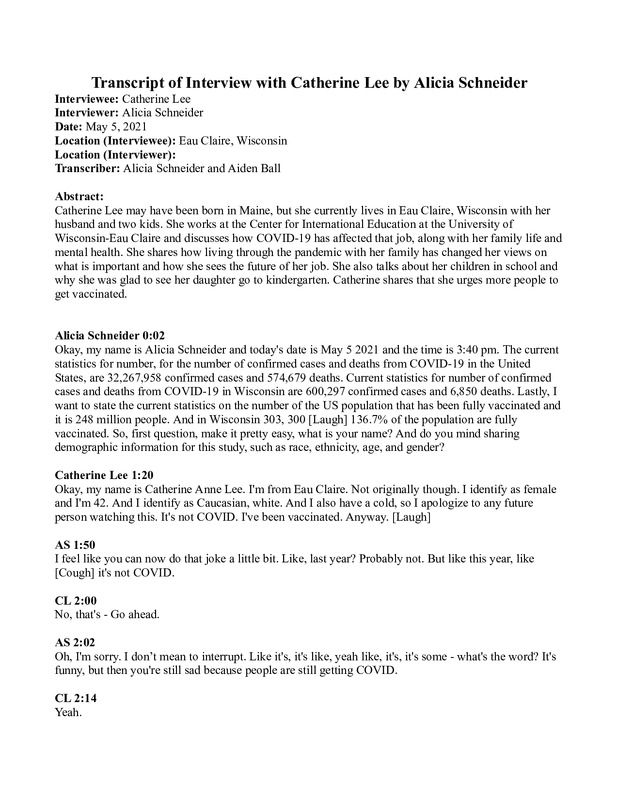 05/05/2021
05/05/2021Catherine Lee Oral History, 2021/05/05
Catherine Lee may have been born in Maine, but she currently lives in Eau Claire, Wisconsin with her husband and two kids. She works at the Center for International Education at the University of Wisconsin-Eau Claire and discusses how COVID-19 has affected that job, along with her family life and mental health. She shares how living through the pandemic with her family has changed her views on what is important and how she sees the future of her job. She also talks about her children in school and why she was glad to see her daughter go to kindergarten. Catherine shares that she urges more people to get vaccinated. -
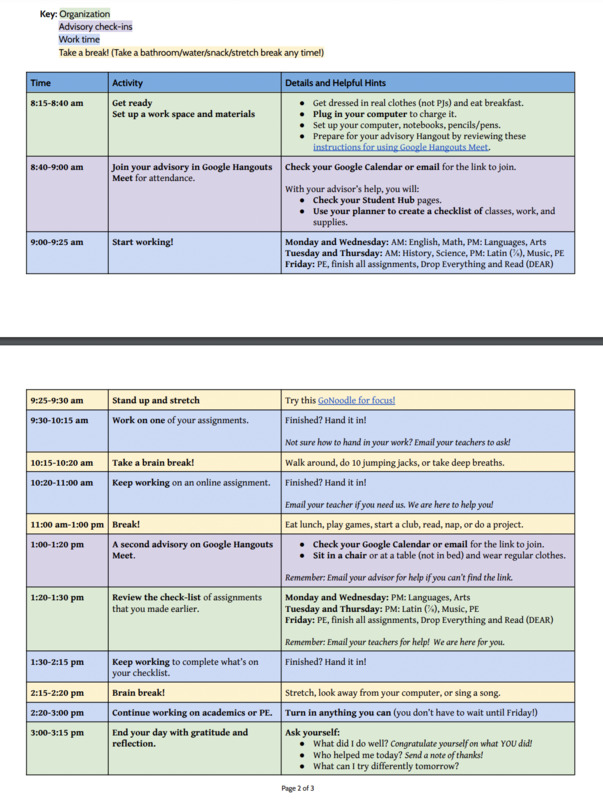 2020-03-24
2020-03-24Sample Virtual Learning Schedule for Middle Schoolers
When we returned from spring break in 2020, we were sent a PDF of a sample schedule. Online school was mostly asynchronous (async) for a few weeks before we switched to a live virtual format. We would usually have one or two synchronous advisories per day and the rest of the day would be independent work. I had just returned early from a family vacation and we had only just begun quarantining. When we received this schedule, we still thought that the shutdown would only last a few weeks before life would return to normal and this schedule marks the very beginning of my pandemic experience. -
2020-03-09
Online School
During the pandemic, I had to participate in an online school. This is one of the zoom links I used to do my online classes. I did not like participating in online school, it was very difficult to learn. -
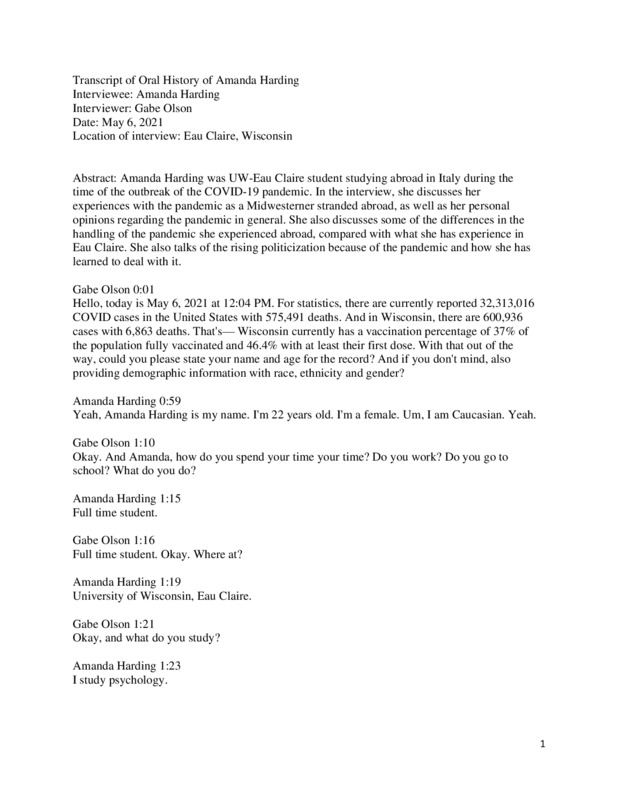 05/10/2021
05/10/2021Amanda Harding Oral History, 2021/05/10
C19OH -
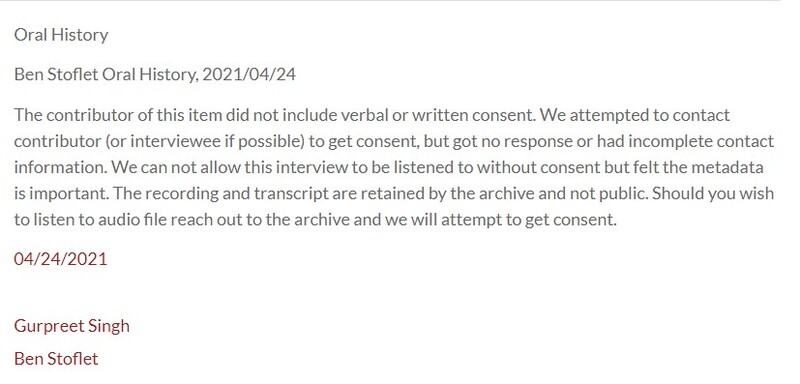 04/24/2021
04/24/2021Ben Stoflet Oral History, 2021/04/24
The contributor of this item did not include verbal or written consent. We attempted to contact contributor (or interviewee if possible) to get consent, but got no response or had incomplete contact information. We can not allow this interview to be listened to without consent but felt the metadata is important. The recording and transcript are retained by the archive and not public. Should you wish to listen to audio file reach out to the archive and we will attempt to get consent. -
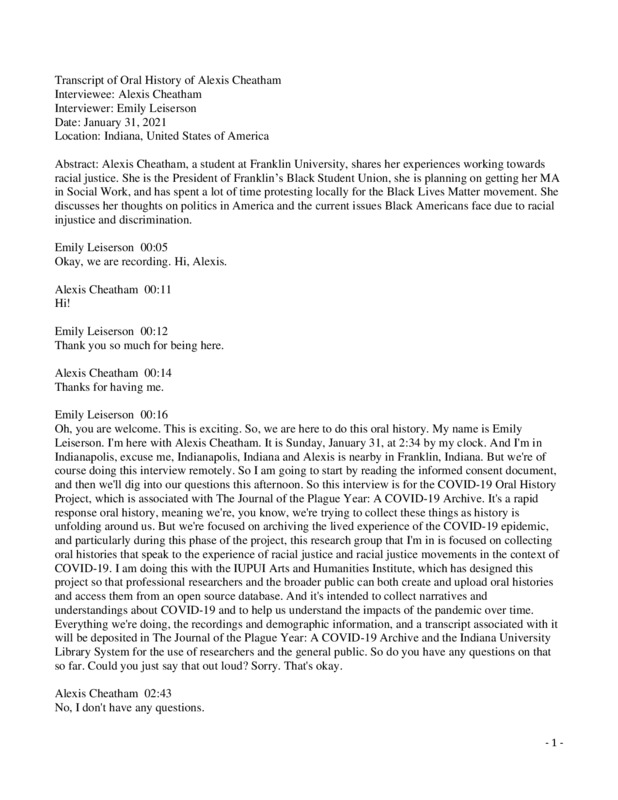 02/19/2021
02/19/2021Alexis Cheatham Oral History, 2021/02/19
C19OH -
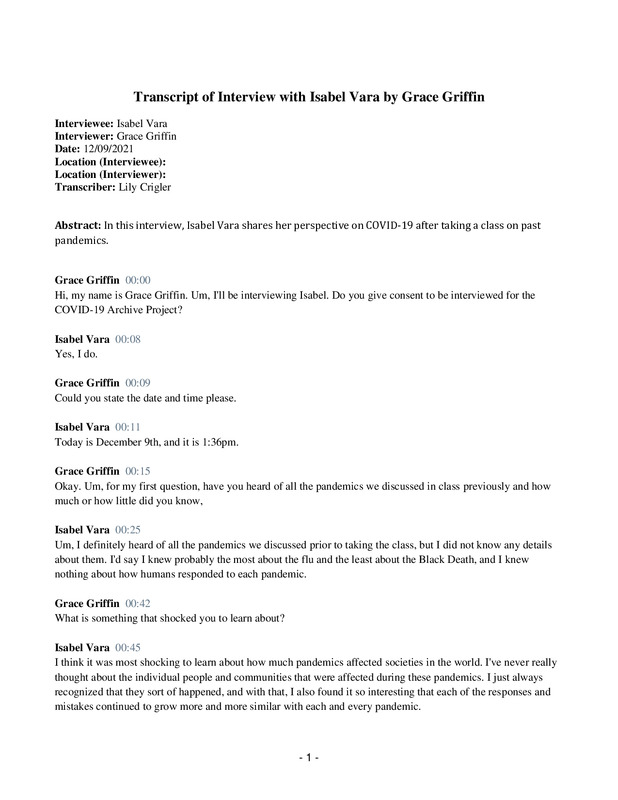 2021-12-09
2021-12-09Isabel Vara and Grace Griffin Oral History, 2021/12/09
The audios I have uploaded share different perspectives on Covid-19 after learning about past pandemics -
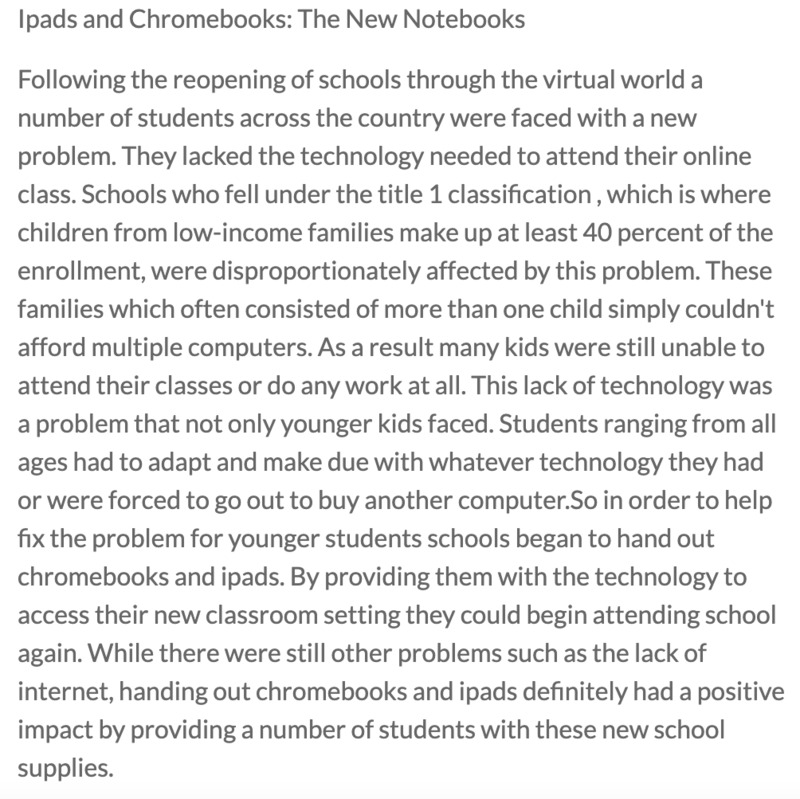 2020-08-11
2020-08-11Ipads and Chromebooks: The New Notebooks
Following the reopening of schools through the virtual world a number of students across the country were faced with a new problem. They lacked the technology needed to attend their online class. Schools who fell under the title 1 classification , which is where children from low-income families make up at least 40 percent of the enrollment, were disproportionately affected by this problem. These families which often consisted of more than one child simply couldn't afford multiple computers. As a result many kids were still unable to attend their classes or do any work at all. This lack of technology was a problem that not only younger kids faced. Students ranging from all ages had to adapt and make due with whatever technology they had or were forced to go out to buy another computer.So in order to help fix the problem for younger students schools began to hand out chromebooks and ipads. By providing them with the technology to access their new classroom setting they could begin attending school again. While there were still other problems such as the lack of internet, handing out chromebooks and ipads definitely had a positive impact by providing a number of students with these new school supplies. -
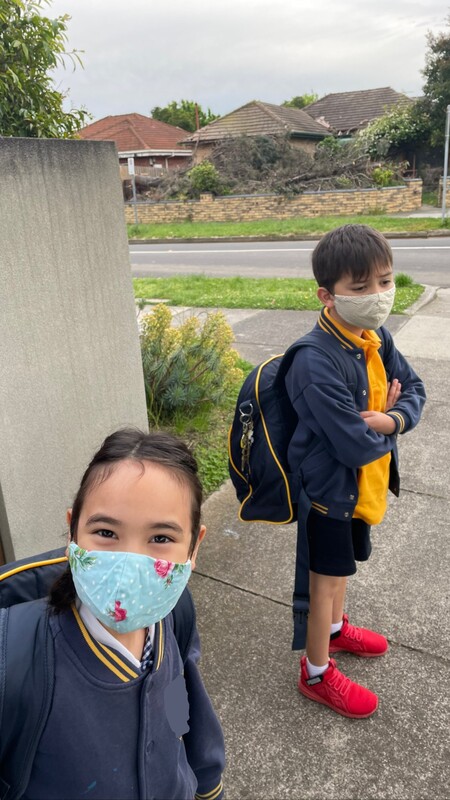 2021-10-21
2021-10-21HIST30060 Back to School
This is an image of my younger siblings on their first day back at school! My sister started her first year of school last year, so her entire schooling experience has been broken up into periods of online learning. Everyone in her grade 1 class is struggling a bit as they haven’t had a proper experience of going to school. It is not mandatory for grades prep to 2 to be wearing face masks in class; however, my brother has been admitted to the hospital a couple of times when he has a bad asthma attack so we’re trying to be as careful as we can. As you can see there are mixed feelings attached to going back to class, both were excited to see their friends and teachers, but will miss spending the whole day at home with dad and me. -
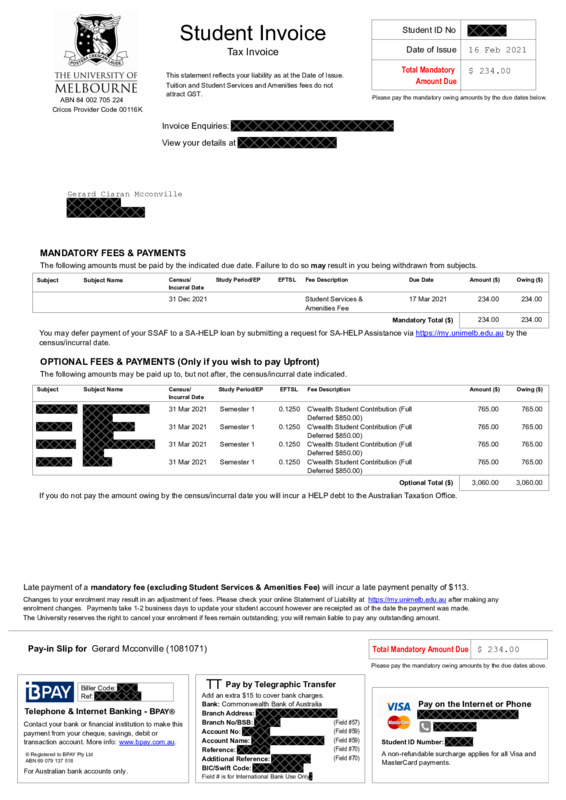 2021-03-01
2021-03-01Amenities Fee - HIST30060
Despite not having been able to attend my university campus for the prior year and not being able to attend it in the coming year as a result of lockdown restrictions, I was still forced to pay an amenities fee to the university. This meant that I had restricted access to the amenities that I was still paying full price for. This combined with losing my job made the payment difficult to make. -
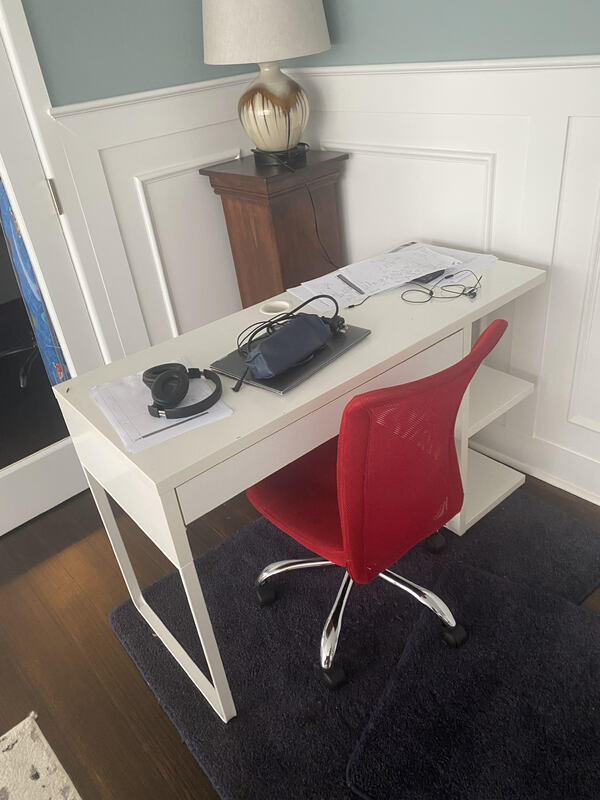 2021-10-08
2021-10-08Home Study for Secondary Students
During the lockdowns, my younger brother had to study at home, as such he asked for mum to buy him a desk that he could use to study on. He ended up using this desk for the entire 5th and 6th lockdown in Melbourne. Often times his desk was filled with sheets of paper and open books, pictured here is the desk in a far more cleanly state. -
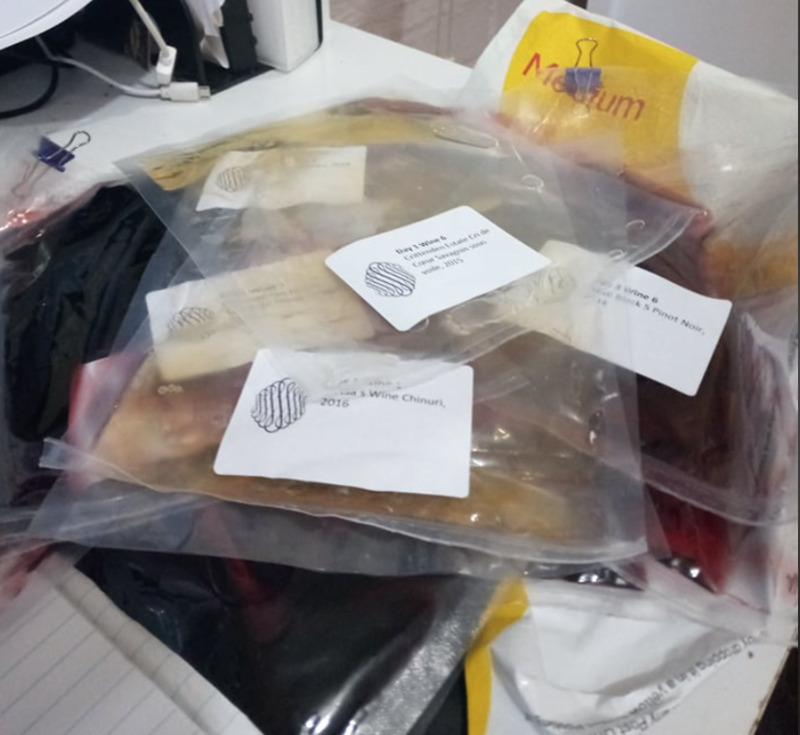 2021-09-07
2021-09-07Rolling with the pandemic
This year, I completed an intensive subject called Wines of the World at university. It was postponed many times due to restrictions, and the subject coordinators eventually decided that they would have to host the course entirely online. A key component of the subject was wine tasting, and this photo shows how this was made possible at home. Wine tastings in sous vide bags were posted to each student's house, a quite exciting and novel experience. This photo thus reflects how educators have had to be flexible around restrictions, and come up with new ways to facilitate learning. -
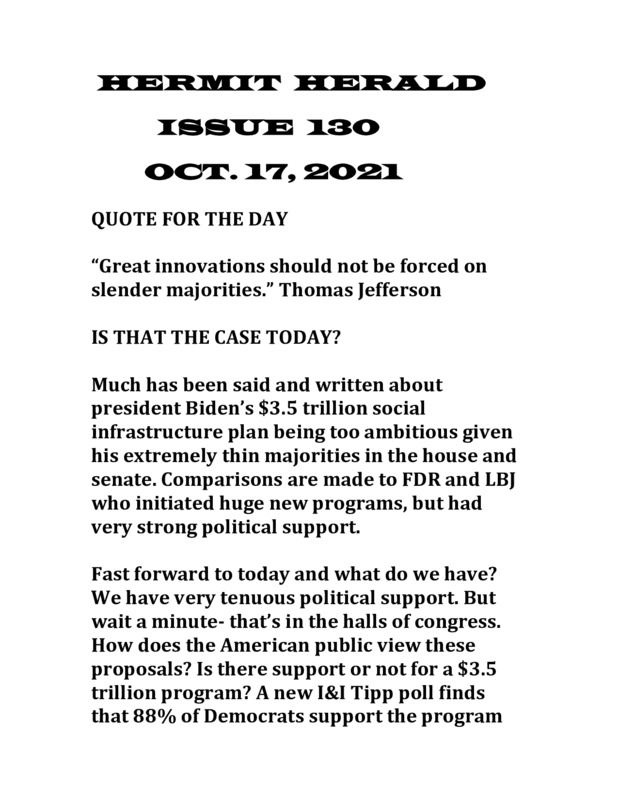 2021-10-17
2021-10-17HERMIT HERALD, ISSUE 130
$3.5 TRILLION BILL, YES OR NO -
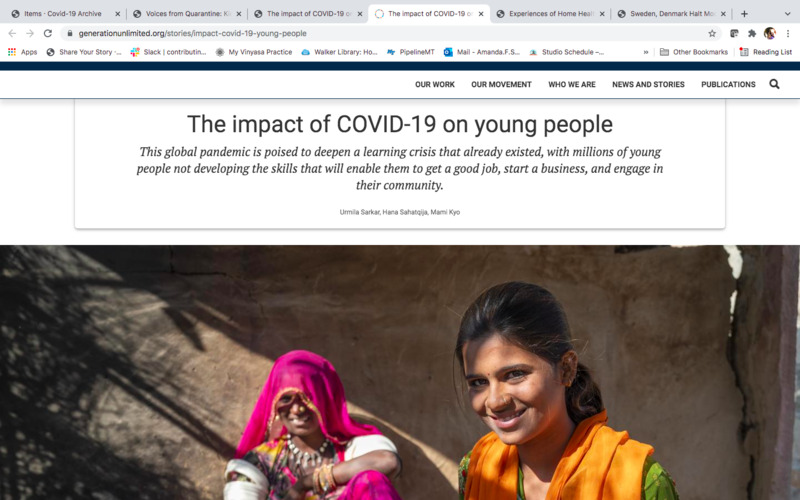 2021-06-15
2021-06-15The impact of COVID-19 on young people
This global pandemic is poised to deepen a learning crisis that already existed, with millions of young people not developing the skills that will enable them to get a good job, start a business, and engage in their community. -
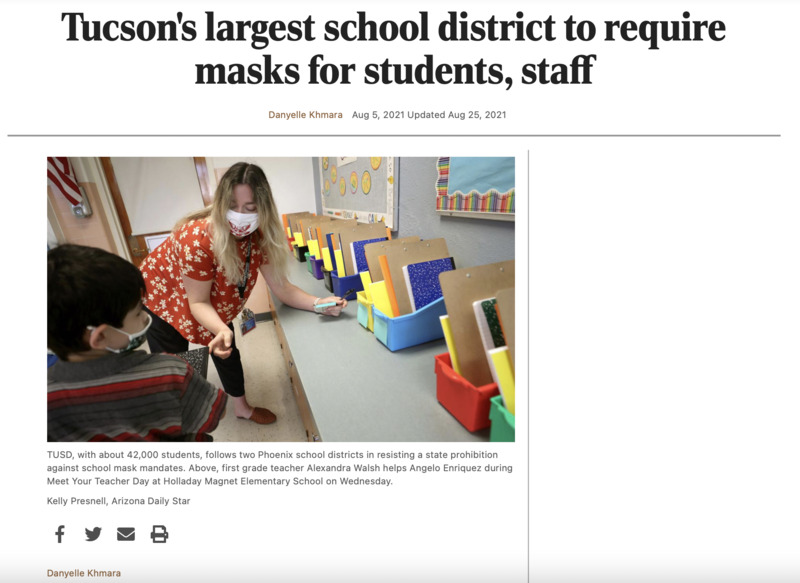 2021-08-05
2021-08-05Tucson Unified requires masks
Arizona Governor Doug Ducey and the Arizona State Legislature have attempted to make it illegal for school districts to require face masks. Tucson Unified School District's school board voted for a mask mandate in defiance of this. Other Arizona districts followed, risking the withholding of COVID relief funds that the governor is refusing to disburse to any district with a mask mandate. A judge later ruled that the law was invalid and schools could have a mask mandate. As someone with children who are in school but are too young to receive a vaccine yet, I hope districts continue to require face masks for the safety of the students and staff. The Arizona Daily Star published a story about TUSD's decision. TEXT OF ARTICLE: Tucson Unified School District is requiring all staffers, students and visitors to wear masks at all its school sites when the school year begins on Thursday, Aug. 5. The TUSD decision defies a new state law that bans public schools from issuing mask mandates. “While Gov. (Doug) Ducey and the state Legislature has decided to ignore the advice of our public health experts and endanger our community, we can’t sit idle and watch COVID inevitably spread throughout our schools and devastate so many TUSD families,” said board member Ravi Grivois-Shah during an emergency Governing Board meeting Wednesday morning. “This is why I will support, along with my colleagues, a requirement to have masks on TUSD campuses and authorize TUSD to enforce this.” The board passed the measure 4-0. Board President Leila Counts was not present for the vote. Masking in schools is an important mitigation measure to slow the spread of COVID-19, and especially the new delta variant, health agencies at the county, state and federal level all say. This week, with Tucson classrooms back at capacity, as nearly 140,000 children across Pima County are returning to classrooms in person, indoor masking is one of the remaining virus mitigation measures schools have left. Social distancing is problematic at most school sites because of large class sizes, and there’s a state ban on a vaccine mandate. Further, a vaccine is unavailable to anyone younger than 12 years old. Between July 20 and Aug. 2, there were 102 virus cases in Pima County schools and 11 outbreaks, according to data from the Health Department. Those figures occurred when most schools here were not yet open. At the end of July, cases in schools accounted for about 8% of the Pima County’s total reported cases, compared to 4% of total cases during last school year — when masks were required. The county also has seen an increase in pediatric admissions and ER visits in children over the last two weeks of July. Vail Unified is the only Tucson school district that has been open for two weeks. Without a mask mandate, the district has 57 current COVID-19 cases in students and 12 in staff workers. The county Health Department has already temporarily closed three Vail classrooms and told staffers and students to quarantine. “Last year, schools had a number of tools that are no longer available,” said Vail Superintendent John Carruth. “They had the ability to do hybrid learning with smaller class sizes, require face coverings and close classrooms if needed. This year, Vail has two instructional options for families — fully in person and fully remote. With all of our teachers assigned to in-person or fully remote instruction, we are leaning on structures we built last year to support students when (the Health Department) requires them to quarantine.” And while some parents, especially those with children not old enough to be vaccinated, fear for their children’s safety in a packed classroom with unmasked people, other parents are staunchly against mask mandates, saying it is unnecessary and even harmful. In an informal survey by the Arizona Daily Star, with 180 participants two weeks ago when the COVID-19 numbers were lower, less than a third of respondents said masks should be optional, in line with the new state law. The other two-thirds said masks should be required or schools should at least have the option to require them. TUSD, with about 42,000 students, follows at least two other school districts in the state, the Phoenix Union High and Phoenix Elementary school districts, in defying the governor and state Legislature by requiring masks. A Phoenix Union teacher sued the district over the mandate, but a court hearing on the case that was set for Wednesday morning was postponed until next week. Science teacher Douglas Hester filed a lawsuit against the Phoenix Union school district’s board members and superintendent on Aug. 2, saying the mandate is illegal and can’t be enforced. A hearing on the case is set for Aug. 13. While most Tucson school districts are strongly recommending that students and staff wear masks indoors, most have also said they don’t intend on mandating masks, including Vail, Marana, Amphitheater, Sahuarita, Sunnyside and Tanque Verde. TUSD Board Member Adelita Grijalva said the mask mandate is necessary for the following reasons: More children are getting sick from the new COVID variant; new evidence has shown that fully vaccinated people may still be able to transmit the virus; the delta variant appears to be more contagious than chickenpox; and many students in the district are too young to be vaccinated. “Probably over 30% of our district cannot be vaccinated because of age,” she said. “I know my youngest can’t. I know many of our children cannot or their friends cannot, and so we have to do everything we can in the district to ensure their safety. That’s our No. 1 priority.” -
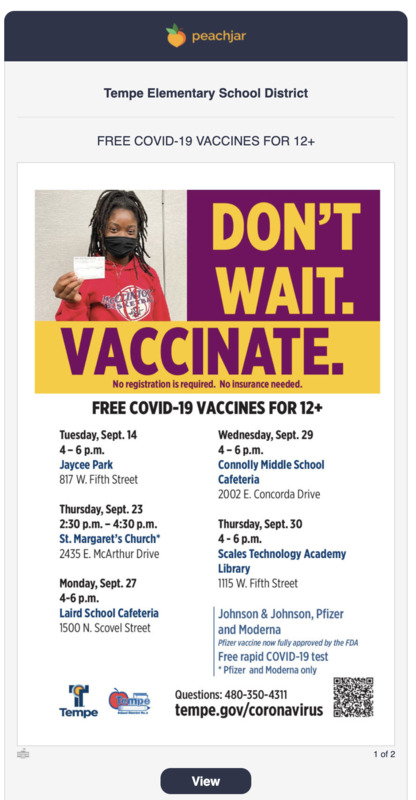 2021-09-23
2021-09-23COVID vaccines for people aged 12+
Tempe Public Schools sent this email today that includes information on free vaccines in Tempe, especially around Scales and Jaycee Park which are both in the same neighborhood. -
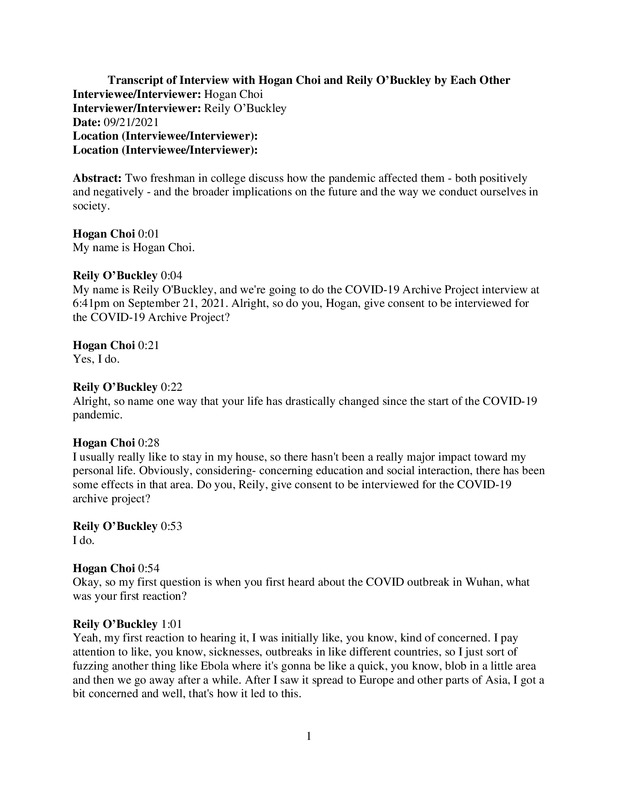 2021-09-21
2021-09-21Hogan Choi and Reily O'Buckley Oral History, 2021/09/21
This is an interview between two Northeastern University students on how Covid-19 that shared their thoughts about the impact of Covid 19 both personally and globally. -
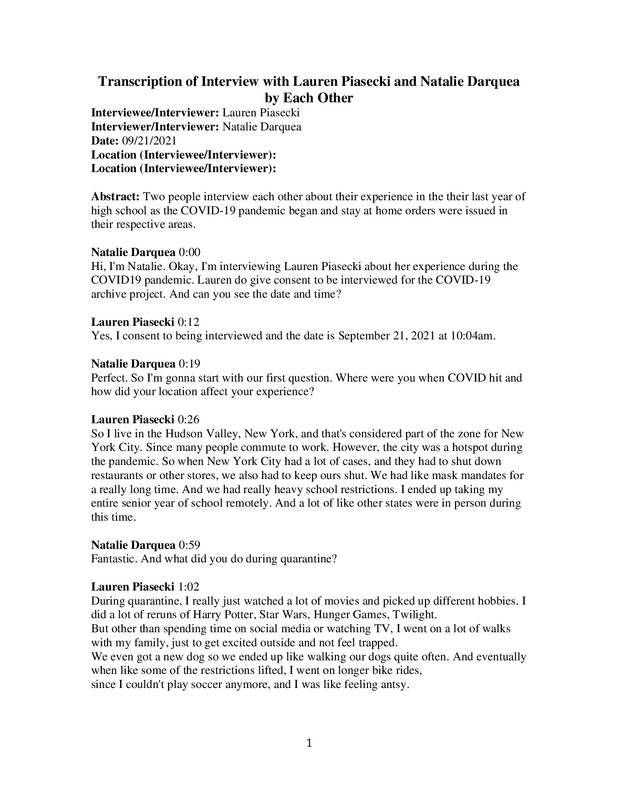 2021-09-21
2021-09-21Lauren Piasecki and Natalie Darquea, Oral History, 2021/09/21
Covid-19 experience at high school students in the US. -
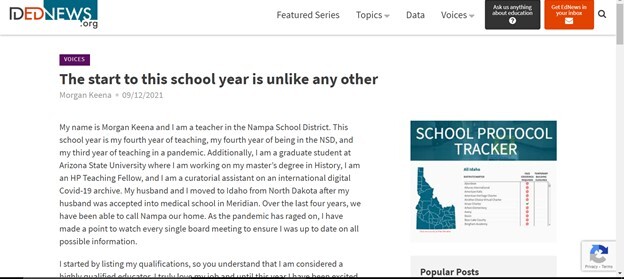 2021-09-14
2021-09-14The Start to the School Year is Unlike Any Other
I wrote an opinion piece for Idaho Education News last week after the latest school board meeting in Nampa, Idaho. Since March of 2020 educators have worked tirelessly to ensure that our students continue to receive a quality education. Initially, educators were seen as 'heroes' of the pandemic. However, over the last 9 months, the rhetoric surrounding schools and teachers has turned nasty. Yet, teachers continue to show up every single day and offer learning experiences to all children. At last week's board meeting, the discussion focused primarily on a mask mandate for our district as hospitals in our state began rationing care given the soaring number of Covid-19 cases. There was an even split between the trustees who were in favor of masking and the trustees who were against masking. This split did not come as a shock to me. However, the line of one trustee hit me in my gut, "I guess I go back to the mission statement. I'm here for the kids, so I'm not going to worry about the adults." The mission and vision statement the trustee is referencing states that teachers offer "exceptional learning experiences" for every child. Given the largely unvaccinated population of our community, the high numbers of teachers out sick, and the alarming number of students out sick as mask mandate seemed like a simple request. However, the board did not vote in favor of helping teachers ensure we are able to provide 'exceptional learning experiences.' Are masks the only answer? Not necessarily. Last year, students attended school 4 days per week while the 5th day was reserved for students to connect with students who were in quarantine/sick and unable to attend school. This year, all of those requirements are gone. That being said, students and teachers attend school 5 days per week and there is no time allotted for teachers to connect with students who are quarantined or sick. Given the latest numbers, about 25% of our entire district is out sick. That is 25% of students who do not have access to their teachers. The article was published on Tuesday, September 14, 2021, and Idaho Ed News shared it on their Facebook page as well. Shortly after 7 pm MST the post has over 160 comments (mostly in favor of teachers), 250 reactions, and over 50 shares. In addition, I have received numerous private messages and emails from other teachers who thank me for giving them a voice during this 'unprecedented' time. While I am still a fairly new teacher with only 3 years of experience, there are veteran teachers who are being pushed to the brink. Many would like to think this is an Idaho problem but the reality is that teachers across the country are feeling unsupported and unappreciated by the communities they serve. I am fearful this will be my last year teaching - I LOVE my job. I remain hopeful that this year turns out to be something amazing. -
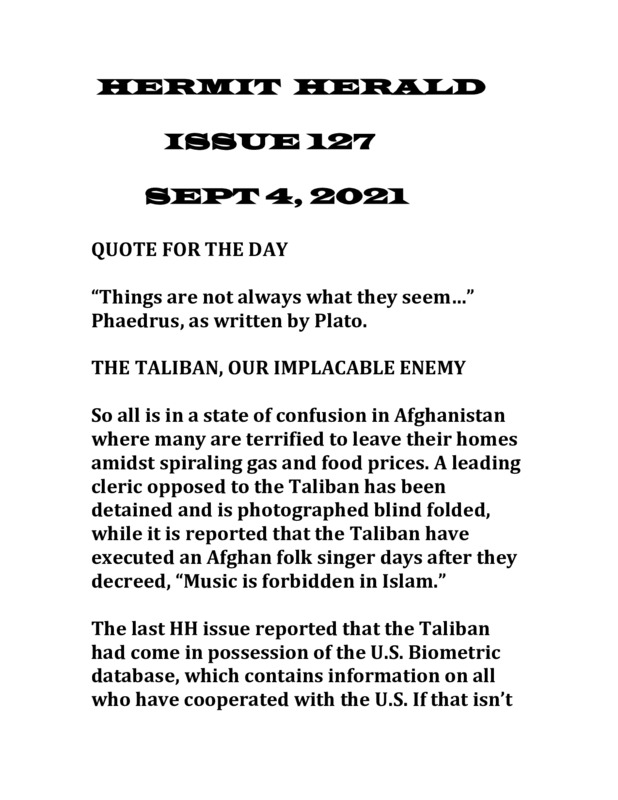 2021-09-04
2021-09-04hermit HERALD, ISSUE 127
Taliban need outside help -
2019-03-07
My Covid Experience
It all happened at the end of my freshman year. a teenager failing classes until what I thought was my savior sent me home for the longest summer I've experienced. It was after summer I realized the horrific effects of the disease. I would have rather stayed in school than lose loved ones to a virus that swept the world by surprise. This is important to me because I have sympathy for people who lost loved ones due to a virus that shouldn't have spread like it did. -
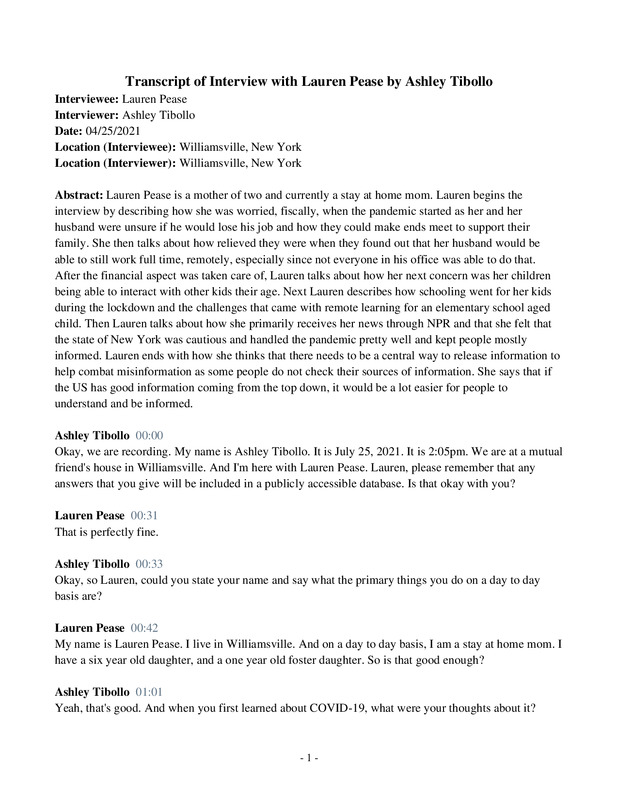 07/25/2021
07/25/2021Lauren Pease Oral History, 2021/07/25
Ashley Tibollo interviewed stay-at-home mom, Lauren Pease about her experience with the Covid-19 pandemic. In this interview, they discuss her experience with the lockdown, her worries about the pandemic, and what life was like during lockdown with her foster child. This interview also touches on political protests, virtual learning and her husband's transition to working from home. -
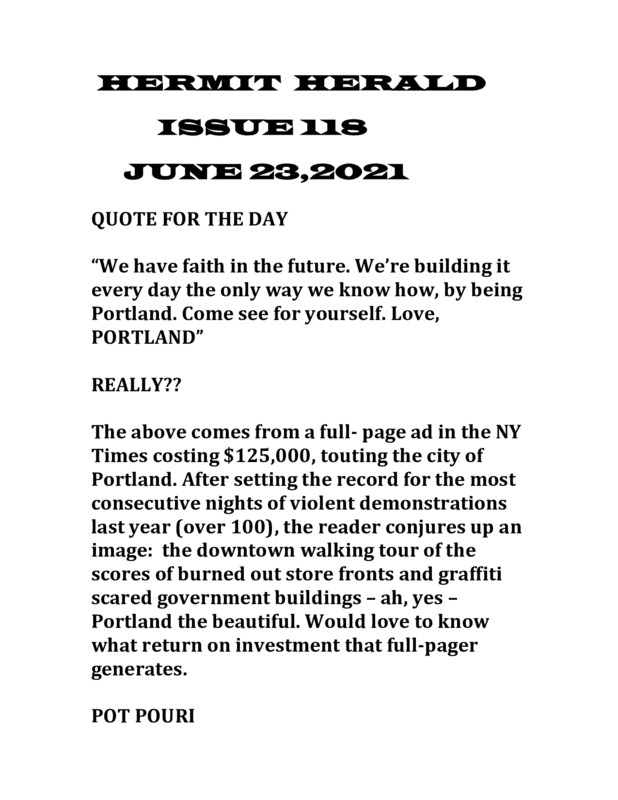 2021-06-23
2021-06-23HERMIT HERALD, ISSUE 118
Portland promotion -
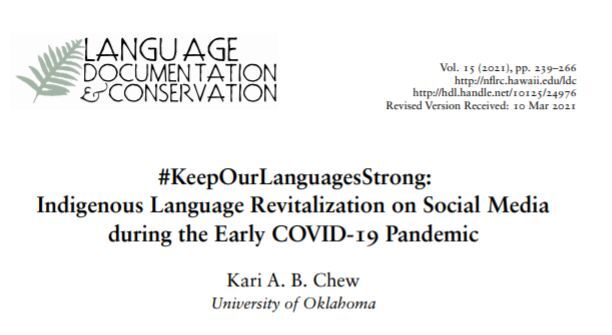 2021-03-10
2021-03-10#KeepOurLanguagesStrong: Indigenous Language Revitalization on Social Media during the Early COVID-19 Pandemic
This is a paper by Kari A. B. Chew at the University of Oklahoma that reviews language revitalization efforts during the early part of the COVID-19 pandemic. The paper focuses on revitalization efforts among Indigenous groups in the United States and Canada. -
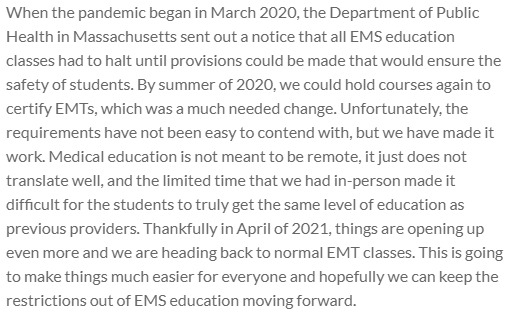 2021-04-25
2021-04-25EMS education in Massachusetts April 2021
When the pandemic began in March 2020, the Department of Public Health in Massachusetts sent out a notice that all EMS education classes had to halt until provisions could be made that would ensure the safety of students. By summer of 2020, we could hold courses again to certify EMTs, which was a much needed change. Unfortunately, the requirements have not been easy to contend with, but we have made it work. Medical education is not meant to be remote, it just does not translate well, and the limited time that we had in-person made it difficult for the students to truly get the same level of education as previous providers. Thankfully in April of 2021, things are opening up even more and we are heading back to normal EMT classes. This is going to make things much easier for everyone and hopefully we can keep the restrictions out of EMS education moving forward. -
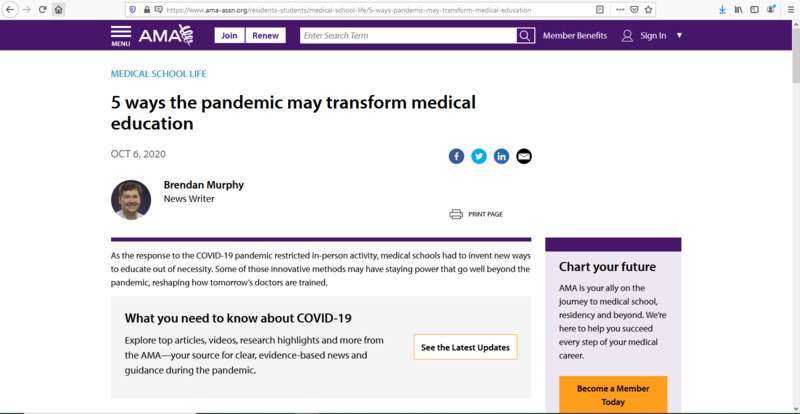 2020-10-06
2020-10-06Medical School's response to Covid-19
Medical schools have had to come up with unique ways to continue to educate future physicians during the lockdowns and pandemic restrictions. This has not been an easy process, and it remains to be seen the long term effect of those who had to go through medical school during the pandemic. However, there will certainly be long-lasting changes to the ways in which we educate medical school students forever after. This article lists 5 ways in which medical school education will be impacted by the Covid-19 pandemic. They are an emphasis on public health, real-time curriculum adaptation, potential to reevaluate graduation requirements, changes in residency selection, and new approach to crisis management. It will be interesting to see how these things impact the quality of physicians down the road. -
 2021-04-07
2021-04-07NC Law proposed would ban Trans Students and Report Them
A new law making its way through the North Carolina legislator would force educators to out Transgender students to their parents. It also would not allow for people younger than 21 to have hormones for transgender surgery or to have surgery or anything like that. -
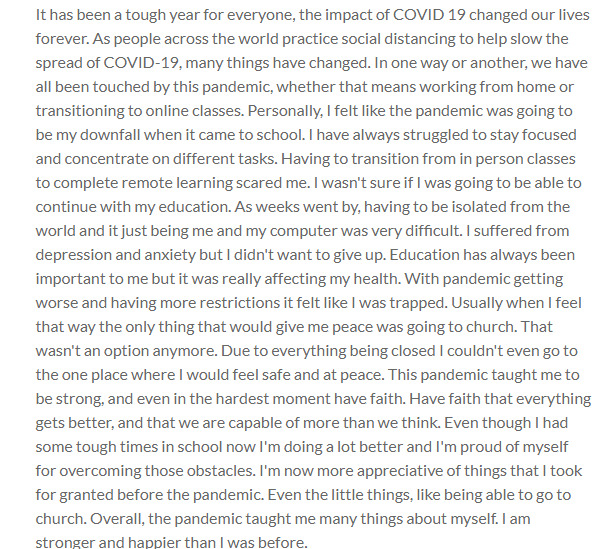 2021-04-23
2021-04-23COVID-19 pandemic
It has been a tough year for everyone, the impact of COVID 19 changed our lives forever. As people across the world practice social distancing to help slow the spread of COVID-19, many things have changed. In one way or another, we have all been touched by this pandemic, whether that means working from home or transitioning to online classes. Personally, I felt like the pandemic was going to be my downfall when it came to school. I have always struggled to stay focused and concentrate on different tasks. Having to transition from in person classes to complete remote learning scared me. I wasn't sure if I was going to be able to continue with my education. As weeks went by, having to be isolated from the world and it just being me and my computer was very difficult. I suffered from depression and anxiety but I didn't want to give up. Education has always been important to me but it was really affecting my health. With pandemic getting worse and having more restrictions it felt like I was trapped. Usually when I feel that way the only thing that would give me peace was going to church. That wasn't an option anymore. Due to everything being closed I couldn't even go to the one place where I would feel safe and at peace. This pandemic taught me to be strong, and even in the hardest moment have faith. Have faith that everything gets better, and that we are capable of more than we think. Even though I had some tough times in school now I'm doing a lot better and I'm proud of myself for overcoming those obstacles. I'm now more appreciative of things that I took for granted before the pandemic. Even the little things, like being able to go to church. Overall, the pandemic taught me many things about myself. I am stronger and happier than I was before. -
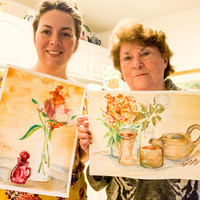 2021-05-22
2021-05-22Ruby Lee Bell JOTPY Portfolio
The JOTPY archives rapidly developed while the Covid-19 pandemic was still new for all of us. I was one of the original interns who joined HST580 as the class, and the archives were being developed. Although, I am not interested in pursuing public history as a career, I was hoping to learn a little bit about public history so I could share what I learned with my own students. Through the internship I gained experience in curating, data collection, addressing silences, community outreach, ethics, and producing oral histories. One of my passions during the internship has been documenting social justice issues in the United States during the Covid-19 pandemic. The pandemic locked us all away inside and pulled the day-to-day agenda away. It became unavoidable during the pandemic but to pay attention to the realities in the States, even those realities some of us were able to comfortably ignore before. For many, social justice issues in America surpassed the urgency of the Covid-19 pandemic. I personally felt an urgency to record the pluralities of the pandemic and the fight for equality in the United States within the archive. The Social Justice collection within the archive grew with submissions from all backgrounds and walks of life. They shed light on both the pandemic and social justice, and how it affected them. I also worked with a team to create the Social Justice Voices in North America exhibition. The collection was designed to amplify the voices of those who fought for social justice during the pandemic. This experience has taught me many skills that I am able to bring my students as an educator. I now understand the large-scale collaborative effort that a rapid response archive requires. I can explain to my students the ethics of information collection, what silences are, and how public historians of today work hard to bridge the gaps in archival accessibility, and this was not always so. This experience has been more fulfilling than I originally expected. I feel incredibly lucky to have been able to make close connections with other interns. I have learned so much from them. I hope to stay in contact with them. -
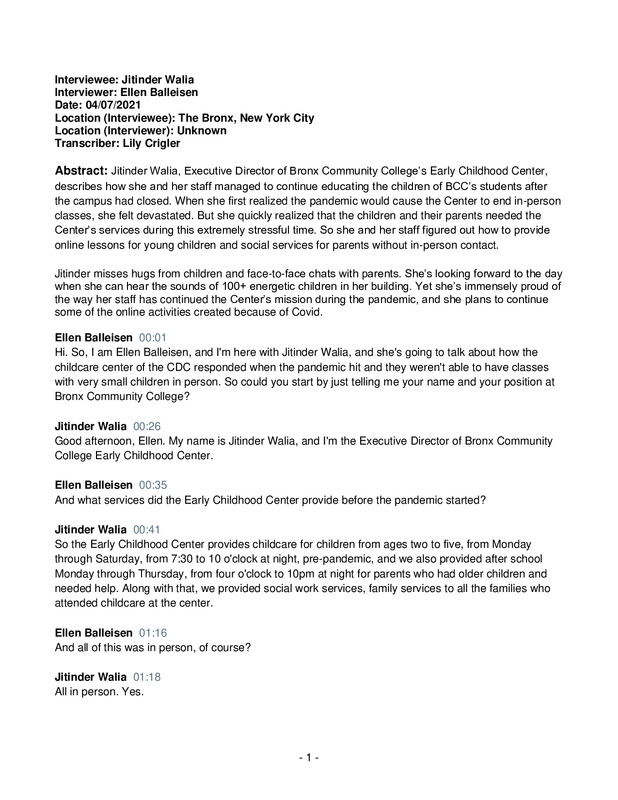 04/07/2021
04/07/2021Jitinder Walia Oral History, 2021/04/07
Jitinder Walia, Executive Director of Bronx Community College’s Early Childhood Center, describes how she and her staff managed to continue educating the children of BCC’s students after the campus had closed. When she first realized the pandemic would cause the Center to end in-person classes, she felt devastated. But she quickly realized that the children and their parents needed the Center’s services during this extremely stressful time. So she and her staff figured out how to provide online lessons for young children and social services for parents without in-person contact. Jitinder misses hugs from children and face-to-face chats with parents. She’s looking forward to the day when she can hear the sounds of 100+ energetic children in her building. Yet she’s immensely proud of the way her staff has continued the Center’s mission during the pandemic, and she plans to continue some of the online activities created because of Covid.
